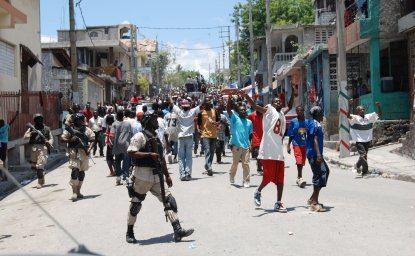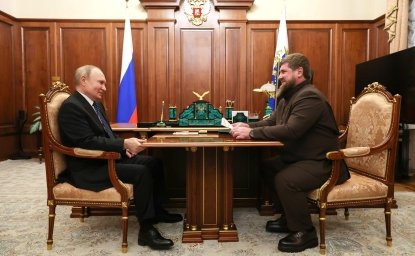"A Hard Country to Love:" Patriotism and National Identity in Russia's Great War, 1914-1918

At the time of Russia’s entry into World War I, the general assumption was “that the imperial government was too backward, too traditional, and too afraid of its own masses to mobilize them,” argued Melissa Stockdale, Associate Professor of History, University of Oklahoma, and Fellow, Woodrow Wilson Center, at a 4 April 2011 Kennan Institute discussion. However, she continued, “we’re beginning to realize the Russian Imperial government and Russian society—oftentimes working together—were engaged in a huge creative project of mobilization.”
The current scholarship on Russia’s participation in the Great War, Stockdale explained, tends to argue that the Russian people were not yet nationally-minded at the start of the war. Rather, it is suggested that citizens imagined themselves more parochially, rather than as part of a national community. In light of that issue, Russia’s entry into the Great War in August 1914 compelled the government to devise a campaign to convince its locally-minded populations to answer the call to arms. This initiative, Stockdale noted, ultimately defined the community and self-identity of the Russian nation, all while trying to get the citizenry to cohere for the sake of war.
Stockdale focused on the techniques used to launch the government’s campaign to mobilize the masses for the Great War. In August of 1914—two weeks after the Russian empire formally declared war—the Imperial government established the Committee of Popular Publications to develop strategies to cultivate national support of the military effort. With ample funding and materials from the government, the Committee produced mass amounts of propaganda in support of the war that the population could obtain easily and inexpensively.
Additionally, the Committee of Popular Publications understood that low literacy levels required that propaganda be published in various media. Posters with portraits of allied foreign leaders, as well as images of the war front, were widely available throughout the country; for the Committee, Stockdale noted, these images helped to explain “who we’re fighting, where we’re fighting, and where we all fit together.” Furthermore, Stockdale described the government’s campaign as an inclusive one that gave consideration to the multifaceted characteristics of the nation’s populations. For example, postage stamps celebrating the nation’s patriotism featured images of cultural achievements of groups that were part of the empire, but not traditionally considered “Russian.” The Committee’s mass production of inexpensive, colorful maps of the entire empire—as well as maps of the war front—allowed communities throughout the country to visualize and understand their role in the framework of the Russian nation, as well as the status of the war effort.
The campaign to unite the country behind the war effort also focused on negative propaganda about the Turks, Germans, and Austro-Hungarians, which the government used to explain to the population why the war was their fault, according to the speaker. Atrocity literature was widely disseminated, which focused on “constructing the image of an external foe … to help unite [the Empire’s] population to fight against them,” Stockdale said. Throughout the course of the war, this propaganda predominantly focused on atrocities Germans committed against Russians, as Russia was faring better on its Turkish front. Stockdale explained that the government’s selectivity in the content of atrocity literature provided the population with an encouraging, albeit skewed, understanding of the status of the war effort.
With the dissemination of war propaganda throughout the Russian Empire, “we see a population hungry for the news,” Stockdale observed. In addition to materials that addressed particular issues, the government continued the mobilization campaign with the establishment of new national newspapers. The Russian Orthodox Church played a critical role in disseminating the information to the population, as it was common that members of the clergy were some of the few—if only—literate people in a village or town. Approximately 35,000 Orthodox parishes were located throughout imperial Russia, and the government would distribute 47,000 copies daily of the Parish Gazette to each parish.
However, “whatever images you propagate of the nation,” Stockdale asserted, “doesn’t necessarily mean that that is the image that the population is going to walk away with.” By fall 1916, the government’s efforts to mobilize the population behind the war effort were failing. “Just because you craft a beautiful image of the just and holy cause of the united people… it doesn’t mean the people are going to buy that,” Stockdale said. Examples of the population’s negative reception of the propaganda included illicit political cartoons that expressed distrust and betrayal within the imperial government; the images suggested “that there were traitors at the heart of the war effort,” according to the speaker.
Stockdale concluded by assessing the success of the mass propaganda campaign during the Great War, noting, “I believe that Russia’s war effort was much more sophisticated, much more modern, than we have tended to believe.” Instead of seeing national mobilization as a Bolshevik or Stalinist creation, Stockdale argued that the campaign should be credited to the later imperial era, despite the ultimate collapse of the war effort.
Blair Ruble, Director, Kennan Institute
Author

Kennan Institute
After more than 50 years as a vital part of the Wilson Center legacy, the Kennan Institute has become an independent think tank. You can find the current website for the Kennan Institute at kennaninstitute.org. Please look for future announcements about partnership activities between the Wilson Center and the Kennan Institute at Wilson Center Press Room. The Kennan Institute is the premier US center for advanced research on Eurasia and the oldest and largest regional program at the Woodrow Wilson International Center for Scholars. The Kennan Institute is committed to improving American understanding of Russia, Ukraine, Central Asia, the South Caucasus, and the surrounding region through research and exchange. Read more




